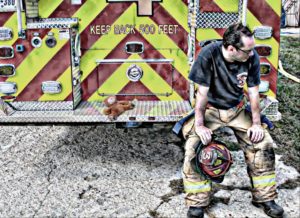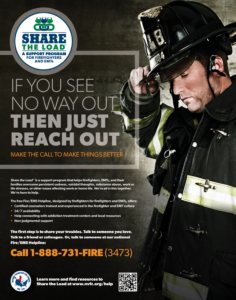By: Robert Avsec, Executive Fire Officer
Every day, firefighters and EMS personnel confront risks to their mental health. But how many of them truly

Source: National Volunteer Fire Council, www.nvfc.org
understand the risk? How many of them know what can be done to limit their exposure to the risk? How many of them understand how mental health issues can manifest themselves
In the past four or five years there’s been a great deal written and talked about to raise everyone’s level of awareness about the mental health issues that can arise from service as a firefighter or EMS provider. Classes have been developed and are being taught. Presentations have been delivered at fire and EMS conferences, large and small. But awareness is only the first step, now it’s time for action
Several weeks ago, I posted about a new friend and ally in this effort that I’d been introduced to by a mutual friend and colleague, Don Prince. In that piece, Rescuer Addiction: Another Voice, I introduced my readers to Stephen Kavalkovich, a former EMS provider and recovering drug addict, who’s started his own efforts to assist his brothers and sisters in their own struggles with mental health issues through his podcasts.
Last week, I had the honor of being Stephen’s guest for an upcoming podcast. During our 40 minutes or so of conversation, I took several notes regarding what we need to start doing to better at protecting our people from the mental health risks of the job and taking care of them when they get in trouble.
3 “Giant Steps” for Mental Health Issues for First Responders
“You can’t cross a giant chasm in two steps.”—Anonymous
We’ve laid the groundwork for change by raising awareness about mental health issues, but now it’s time for some bold action on everyone’s part. Here are three “giant steps” that I think we need to make in fire and EMS regarding mental health and the challenges presented by working in the business.
Break down the “wall” between physical injuries and mental injuries. When a firefighter or EMS provider suffers a physical injury, e.g., sprains an ankle or strains their back, there’s no stigma attached to that injury. It’s implicitly understood that even when everything is done right, physical injuries can still happen; it goes with the physical nature of being a firefighter or EMS provider.
But when a firefighter or EMS provider suffers a mental injury, e.g., PTSD, or self-medicates using drugs or alcohol to deal with the stresses of the job, there’s a stigma attached to such outcomes. The person wasn’t tough enough. Or they took the easy way out rather than facing their demons, especially if the outcome was that the person took their own life.
Departmental policies and procedures need to be changed to reflect a paradigm shift that puts mental health

Source: National Volunteer Fire Council, www.nvfc.org
injuries on par with physical injuries. How many firefighters have received disciplinary action when they suffer a line-of-duty injury, even when it might have been through their own improper behavior? How many firefighters, however, have received disciplinary action because they failed a random drug test or received an off-duty DUI?
I’m not advocating for relaxed disciplinary policies. No, I’m advocating for policies and procedures where the “default mode” is that those unwanted behaviors might be the first warning signs of an individual who’s having job-related mental health issues. Or an individual who’s having off-the-job mental health issues. In either case, departmental leaders should focus on finding out what the real problem is first and getting the individual the professional assistance they might need.
We must understand that the manifestations of stress, like PTSD or addiction to drugs or alcohol, are something a person has, not what that person is.
We’ve got to get better at proactively protecting our people from the mental health exposures that come with the job. We must accept that firefighter or EMS provider safety is as much about their mental state as their physical state. In a piece, 4 strategies to reduce firefighter stress, I wrote about what a company officer or first-line supervisor can do to boost the crew’s emotional hygiene.
On the emergency scene, our tactical leaders must learn to recognize that firefighter or EMS provider safety is also about protecting the mind from the barrage of witnessed trauma. In a piece I wrote for FireRescue1.com, Why firefighter mental safety is like a hazmat scene, I outlined how following basic hazmat scene protocols when dealing with an emotionally difficult scene can help reduce the level of mental health risk to firefighters.
Change the culture of fire and EMS so that everyone accepts mental health injuries for what they are, injuries. We must move to the place where physical injuries and mental injuries are looked at as being equal risks associated with being a firefighter or EMS provider.
In both the fire and EMS worlds we take pride in our camaraderie, our teamwork, and our sense of family. Well,

Source: iowalabornews.com
this somewhat dysfunctional family must change how it looks out for each other, and that can only start by understanding how stress affects us and our team members.
Too many firefighters and EMS providers still adhere to a mind-set that mental health issues are something that happens to other people, but not them. Because to believe otherwise requires them to admit their own human frailties. They rely on this sense of denial about the realities of mental health risks as a “shield”, but it’s a “paper shield” at best.
So, let’s work on taking these three giant steps and start heading towards a new reality. A reality where we accept that mental health risks are part of the job, there are things we can do to minimize the risks, and that when someone is injured by that risk it is incumbent upon each of us to be able to recognize the possible signs of that injury. And lastly, that we provide support to our team member in their journey to recovery. Because that’s what we do, right?
 Fire & EMS Leader Pro The job of old firefighters is to teach young firefighters how to become old firefighters!
Fire & EMS Leader Pro The job of old firefighters is to teach young firefighters how to become old firefighters!